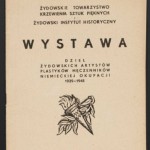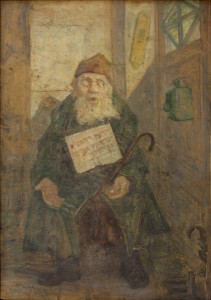In 1948 the Jewish Society for the Promotion of Fine Arts (a precursor, as I understand it, to the ŻIH/The Jewish Historical Institute) planned and hosted an exhibition that included three of Moshe Rynecki paintings. The exhibition, Wystawa dzieł żydowskich artystów plastyków męczenników niemieckiej okupacji 1939–1945 [Exhibition of Works of Jewish Artists Martyrs of the German occupation 1939-1945] included 3 Rynecki paintings.
Only the titles are listed in the catalog: Przy szachach – A game of chess, Slepy zebrak – Blind Beggar, and Żyd przy pracy – Jew at work
Although the catalog does not include photographs, I’m pretty confident that Blind Beggar is this one. The text on the beggar’s sign says:
יודען רחמנים שענקט נדבה – Which translates, roughly, I’m told to: Merciful Jews, spare a donation.
I found this written about the exhibition in the 2008 book, Under the Red Banner: Yiddish Culture in the Communist Countries in the Post War Era, “The Society [ŻTKSP – The Jewish Society for the Promotion of Fine Arts] did not forget one of its most important tasks – preparing exhibitions. In the course of three years of activity, until the end of 1949, it organized four exhibitions that were presented in all of Poland – two individual ones: in 1946 Rafal Mandelzweig (Human Martyrology, 1939-1954), and three years later that of Lea Grundig – an Israeli artist who was originally from Germany, as well as two collective exhibitions. The opening on 19 April 1948 of the Exhibition of Works of Jewish Artists Martyrs of the German Occupation 1939-1945 accompanied the commemoration of the 5th anniversary of the outbreak of the Uprising of the Warsaw Ghetto. A subsequent exhibition – Rescue Works of Art of Jewish Artists, which was open to the Warsaw public from 29 August to 5 October 1948, presented pictures, drawings, graphic works and sculpture that had been purchased by the ŻTKSP. In the following year, from February to June, the exhibition traveled around Lower Silesia: to Wrocław, Dzierżoniów, Świdnica, Walbrzych and Legnica. According to data in a report for the Ministry of Culture and Art, nearly 10,500 individuals, including 3,390 in Dzierżoniów, visited the exhibition at that time.”
Thank you to Chasing Portraits supporter and friend of the project, Marianka Natanson, for finding this information in the Centralna Biblioteka Judaistyczna database!


